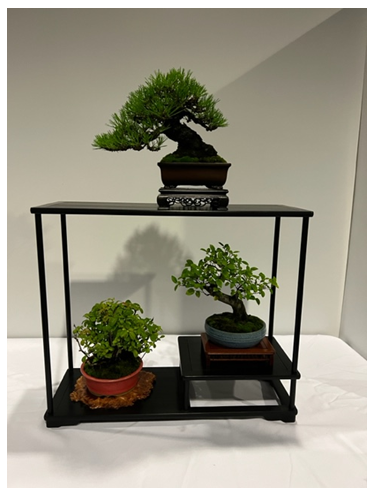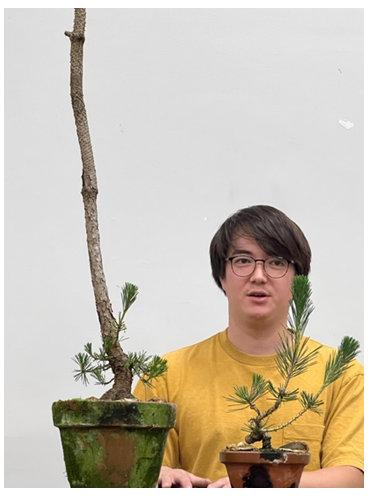Towards the end of 2022, BSA was fortunate to have Evan Marsh give a demonstration on growing Shohin bonsai. Evan is well known for his prize winning Shohin and has studied with Koji Hiramatsu who is an expert Shohin grower and board member and instructor for the All-Japan Shohin- Bonsai Association.

Shohin are small bonsai. The word literally meaning ‘small goods’ and although no exact rules were ever formulated, Shohin are considered to be under 20cm tall or be able to be held on the palm of a hand.
Shohin displays are complex and may have from three to nine elements- the bonsai, an accent plant/s, an ornament and/ or a scroll. Suiseki may also be included. At the Kokufu exhibition the rule is that no two elements can be the same; trees must be different styles, pots must differ in both shape and colour and each tree must be on its own stand (each different) on the larger stand. Trees are placed according to their directional flow and species. Pines and conifers are always at the top and flowering trees are always at the bottom.
Many of the Shohin trees we see in shows in Australia have been achieved by reducing a larger tree to the desired size. However, thinking has changed. Evan explained that bonsai practice is now to grow Shohin from the start with a small tree in mind, practically throwing away ‘left, right, back’ thinking because it doesn’t work for Shohin. It’s more about ‘Where is there space?’ and ‘How can it be filled?’ when creating a Shohin. Space is the ‘enemy’ as it makes a Shohin look immature. A rounded canopy makes a small tree look good and older.

Pines and junipers are important for Shohin displays and are placed on the outside of the display. They are needed for strength. Evan starts from Day 1 using appropriate techniques for each species he grows. Pines must have a good nebari and trunk and these have to be developed. Firstly, Evan dramatically twists the trunk, bending it into a loop on a very flat plane and wires it into place. At the same time, he combs out the roots to develop the nebari and the tree is then planted into a training pot using pumice to create a fine root system. The tree is not repotted until Evan wants to create a Shohin and it is then, when the pine is placed in an inorganic mix of equal parts of akadama, pumice and scoria that the growth slows down.

Sacrifice branches are very important for trunk development and faster growth when developing pines and indeed, all Shohin. Evan keeps the sacrifice branch as long as possible and creates two zones. He keeps as many low buds as possible and plucks out the needles in between these and the top of the sacrifice branch. The growth on the lower part is what is wanted. It doesn’t have to be strong, but it does have to be there! Most years, the pines are candle cut to encourage back budding. All developing trees are well fertilised.
The nebari is less important for a Shohin juniper as the strength of the trunk and deadwood compensate for this. Initially, Evan bends the trunk and twists it back on itself, wiring the branches with view to future jins which will enhance the tree’s character and imply age.

Once again sacrifice branches are used to promote growth and the trees are well fertilised. Fertilising regularly is important as a smaller pot size needs both more water and fertiliser.
Other species for Shohin include maples, zelkova, celtis, crab apples, cotoneaster, pyracantha and figs.
If you’d like to see more Shohin, you might enjoy this post from the Valavanis Bonsai Blog
https://valavanisbonsaiblog.com/2023/02/05/2023-california-shohin-bonsai-society-seminar/
